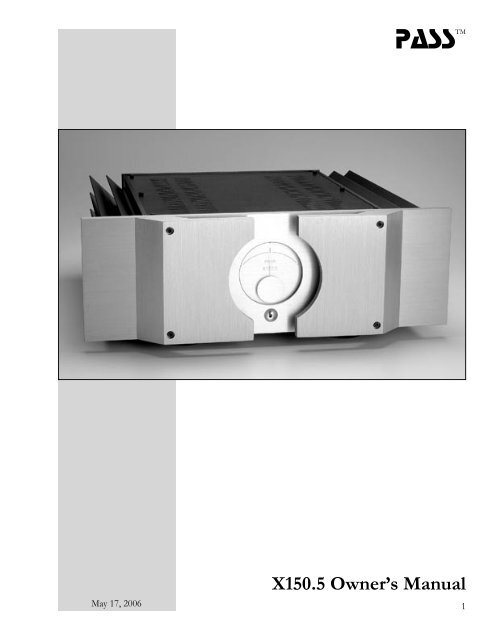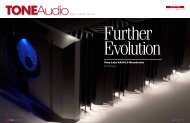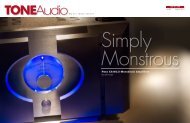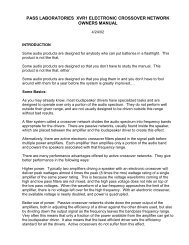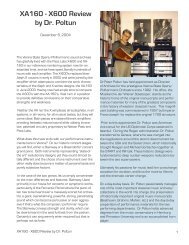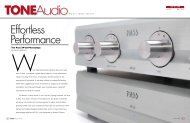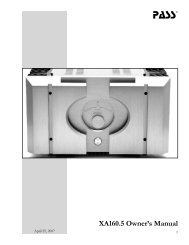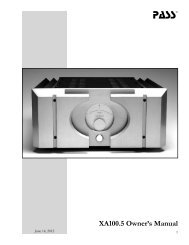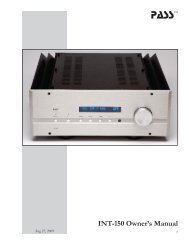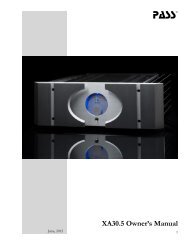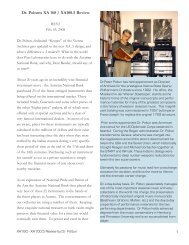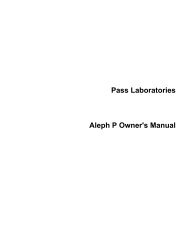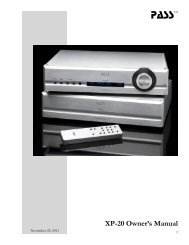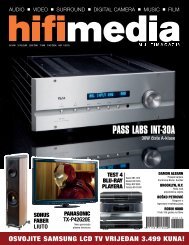X150.5 Owner's Manual - Pass Labs
X150.5 Owner's Manual - Pass Labs
X150.5 Owner's Manual - Pass Labs
Create successful ePaper yourself
Turn your PDF publications into a flip-book with our unique Google optimized e-Paper software.
passTM<strong>X150.5</strong> May 17, Owners 2006<strong>Manual</strong><strong>X150.5</strong> Owner’s <strong>Manual</strong>1
IntroductionThe <strong>Pass</strong> Laboratories <strong>X150.5</strong> stereo amplifier embodies the designtechnology and refinements of the “X” series amplifiers including extensionsof the patented Supersymmetry circuit. Additionally selectedrefinements of the XA series amplifiers have been incorporated into the<strong>X150.5</strong> to significantly improve this products sonic performance in comparisonto it’s immediate predecessor, the <strong>Pass</strong> Laboratories X150.The Supersymmetry circuit topology was granted a U.S. patent in 1994,and was the result of 19 years of effort by legendary analog designer andcompany founder Nelson <strong>Pass</strong>. The amplifier uses highly matched componentsin a classically simple single ended Class A circuit. The amplifiercontains only two simple stages: the first is a balanced Class A gain stage.Its output drives a bank of high power devices operated as followers.These are inherently low distortion types of circuits, but their performanceis improved when operated balanced. Distortion and noise identicalto both halves of a balanced circuit will disappear at the output, andin a well-matched symmetric circuit, most of the distortion and noise isidentical.Supersymmetry enhances this effect by providing a connection betweenthe two halves of the balanced circuit that further perfects thismatch. Any distortion and noise not already identical to the two halves ismade more identical by a factor of about 10, and the result is improvednoise cancellation at the output of the amplifier.Unlike feedback techniques where the goal is to correct for the distortionby feeding a gain stage an inversely distorted signal, Supersymmetryseeks merely to create perfect matching.Matched balanced power circuitry typically sees a distortion and noisereduction of about 90% (20 dB) through a balanced connection withoutany additional effort. The Supersymmetry circuit delivers another90% reduction, so that the X series has about 1/100 of the distortion ofa conventionally simple amplifier. Distortion and noise can still be seenat the output of one half of the circuit, but since it is virtually identicalon the other half, it goes away at the speaker terminals. This gives goodmeasured performance, which because a simple circuit produces it, alsosounds excellent.Previously these kinds of simple Class A circuits have been popular fortheir sound quality in low power amplifiers, but have not found applicationat high power levels due to excessive distortion and low efficiency.Supersymmetry overcomes this barrier, delivering the sweetness, staging,and detail of very simple circuitry up to kilowatt power levels andbeyond.<strong>X150.5</strong> Owners <strong>Manual</strong>2
The X.5 Series amplifiers have the tremendous dynamic range (>140dB) to do justice to the high-resolution digital recordings of the 21stCentury and the elegance to retrieve the micro dynamics offered bythe most sensitive loudspeakers. The simple but powerful circuitrymoves easily from total silence to explosive transient and back tosilence without a trace and without information loss. Very unlikeconventional high power amplifiers, they provide this level of powerwith a subtlety befitting some of the better tube amplifiers. This performanceis consistence across the audio spectrum and the amplifiersare unconditionally stable into all speaker loads.So relax and enjoy your amplifier. Call us if you ever have a problemor question. You are welcome to ask questions or offer comments.Thank you for buying our product.<strong>X150.5</strong> Owners <strong>Manual</strong>3
SetupYou can position this amplifier most anywhere you wish, but it requiresadequate ventilation. We do not recommend placing it inenclosed cabinets or small closets without means for air to circulatefreely. Stacking these power amplifiers directly upon each other is notrecommended for the same reason. This amplifier typically idles atslightly more than 250 watts, most of which dissipates as heat acrossthe heatsinks. As a point of reference, these heatsinks should neverbecome too hot to touch for several seconds.Let’s talk about AC power requirements. This amplifier draws about2 amps (continuous rms) at 120 volts out of the wall during normaloperation, and this power draw reflects mostly the idle current thatwe run through the output stage. If you are driving a low impedanceload, you will draw more power than this, but this will not be typical.The amplifier’s voltage and current rating are indicated on the rearpanel. It will be 240 volts, 220 volts, 120 volts or 100 volts, all withan appropriate rear mounted replaceable type 3AG slow blow fuse.For units rated at either 220 or 240 volts the fuse will be a 2-1/2 amptype 3AG, 250V slow blow and for units rated at either 100 or 120volts the fuse will be a 5 amp type 3AG, slow blow. Do not substituteother types, voltage, amperage or time constant fuses for the specifiedreplacement.The frequency rating of the AC line source in all instances will be 50 to60 Hz. Please verify that the amplifiers indicated voltage requirementsare consistent with the line voltage supplied at your location.The <strong>Pass</strong> Laboratories <strong>X150.5</strong> is provided with a conventional IECdetachable AC line cord, which is rated at 15 amps. The safety groundis attached to the chassis in the conventional approved manner. TheAC power input to the amplifier runs through a RF filter, which removeshigh frequency noise coming into and going out of the amplifierpower supply.Under no circumstances should you defeat the ground connection ofthe power cord. For your safety, the chassis of the amplifier should beearth grounded. Signal ground is isolated from chassis, safety ground,to reduce the incidence of ground loop noise. The presence of asafety ground will not degrade the audio signal chain.You may substitute an aftermarket detachable IEC 320 style powercord of your choosing; provided it is rated for at least 15 amps and itmeets all legal requirements and has been approved by the local testingauthority for such things.<strong>X150.5</strong> Owners <strong>Manual</strong>4
Looking at the rear panel you will see the IEC 320 AC power cordreceptacle, a mains power switch, two pairs of output connectors, apair of binding post connectors for remote turn-on, two RCA inputconnector and two XLR balanced input connectors.Make sure that the mains power switch is off (down). Plug the ACcord into the back of the amplifier, and then into the wall. Then turnthe breaker switch on (up). The lights in your house may blink whenthe power supply charges the capacitors; this is normal. This mainspower switch is not to be used as a safety disconnect during servicingand is not a substitute for unplugging the power cord.On the front panel, the “Standby” LED indicator should be glowingblue, indicating that the power is on. The “Power” LED should notbe on. If the “Power” LED is on, don’t get excited, just use the frontpanel stand-by button to go into stand-by mode, with the “Standby”LED on and the “Power “ LED off.OK, so the amplifier is sitting there in stand-by mode with just thesingle blue LED lit. No speaker connected, as yet. You can go aheadand connect the source and speakers. Some speaker cables are verydifficult to work with due to physical size and construction, make surethe speaker connections do not short together. It is recommendedthat you connect the speaker ends of these cables first.Some powered subwoofers require an audio signal ground referenceand their makers may suggest that a black speaker terminal is wherethis voltage reference might be found. On complementary designs,which would be typical of all power amps produced by <strong>Pass</strong> Laboratories,this is an incorrect and unsafe assumption. On all <strong>Pass</strong> Laboratoriespower amplifiers a reference of 0 volts will be found only atpin 1 of the XLR input or at the shell of the RCA input.Reference connections for these devices require special considerationwhen used with our product. If you have such a device, and wish touse it with our product, please contact our Foresthill, California factoryfor specific instructions.... you have been warned.XLR input connector showingproper placement of jumper pinfor use with single-ended (RCA)input.Note: On <strong>X150.5</strong> XLRs areupside down.<strong>X150.5</strong> Owners <strong>Manual</strong>5
The amplifier can be driven single-end or balanced, if driving the amplifiersingle-ended, leave the supplied jumper in place (between pins1 & 3 on the XLR). Your amplifier will operate without the jumper inplace, but performance will be significantly diminished.Now that the source component is connected, make sure there is nosignal coming from it, probably by turning the volume all the waydown. With the speakers connected, push the front panel button toactivate the amplifier. The “Power” LED will come on.You are ready to play musicDo everybody a favor and try not to have shorted output cables. Ithappens accidentally all the time, and the amplifier is designed to survive,mostly.Of course it’s always possible that something could go wrong. If so,don’t get excited, just relax. It’s really aggravating when something likethis doesn’t work, we understand, but it will get fixed. We go to a lotof trouble to make products reliable, and the failure rate of our amplifiersis very low. This is small comfort to the few, but take it easy andgive us a call if you have problems.People are often interested in how long it takes for these amplifiersto break in. Perhaps a more salient question is how long does it takethem to reach their sonic best after turn on. It takes about an hour forthem to fully warm up, and this is where we adjust them first. Thenwe adjust them again and again over a couple of days, keeping the biasand offset in the sweet spot. Our environment is about 23 degreesCentigrade and the heat sinks will rise approximately 25 degrees C.above that, for an average on heat sink temperature of 48 degrees C.Sonically they are at their best when the heatsinks are approximately50 degrees C.In your setup the temperature may vary a bit due to line voltage variationsand ventilation, but this is not a big deal. You should be able toput your hands on the heat sinks without discomfort for 10 secondsor so. It is normal for the heasink temperature to vary side-to-side andfront to back.The amplifier has a thermal cutout that will disconnect AC power ifthe temperature exceeds 75 degrees Centigrade. This should neveroccur in real life.More things to knowYou can remotely operate the stand-by mode by applying 12 volts DCto the single pair of binding post connectors on the rear of the ampli-<strong>X150.5</strong> Owners <strong>Manual</strong>6
fier. The positive of the 12 volts DC goes to the red connector. Thisconnection has an actual operating range of about 9 volts to 15 voltsat a current draw of approximately 5.0mA. This switching will overridethe front panel button, so if you want the front panel button tooperate, leave the rear connection open.So much for the most essential information.Speaker InterfaceThe <strong>Pass</strong> Laboratories <strong>X150.5</strong> is optimized for loads nominally ratedat 4 ohms and above. You can run the amplifiers into a lower nominalimpedance without difficulty, and we are not aware of a speaker on themarket that presents unusual difficulty with these amplifiers.The X.5 series amplifiers do not care particularly about the reactivity ofthe load. Reactive loads typically will have slightly less distortion at agiven voltage/current level than resistive loads, but will make the amplifierrun a little hotter. The X.5 circuit was designed to be quite happydriving electrostatic and other difficult speakers.When driving transformer-coupled loads directly, as in some electrostaticand ribbon designs, some attention must be paid to the DC characterof the situation. If the transformer primary is being driven raw with noprotection from DC and your source has DC voltage, or in cases wherethe small offset of the power amplifier is still too much, you may createdistortion in the transformer and get less than optimal performancefrom it. Generally this is not the case with transformer-coupled loudspeakers,but it does occasionally surface. In these cases, take specialcare that the source does not contain a differential DC component, andconfirm the differential DC offset of the pre-amplifier is sufficientlylow. This differential voltage is easily adjusted by a qualified technicianarmed with the appropriate service documents.Interconnects and SpeakerCablesWe have a general recommendation about interconnects, which is thatthey should cost less than the amplifier, and be flexible enough to workwith. We have tried a lot of products and most of them work well, butas a practical matter we cannot make blanket recommendations.The amplifier is not sensitive to source interconnects or ground loops.It is also not sensitive to radio frequency pickup, which allows someflexibility in choosing source interconnects without shields, thoughshields are always in good taste.We prefer speaker cables that are thick and short. Silver and copper arethe preferred metals. If you find any cable made of gold, please gift usa couple hundred meters.<strong>X150.5</strong> Owners <strong>Manual</strong>7
Fortunately the amplifier is not sensitive to the capacitive/inductivecharacter of some of the specialty speaker cables, so feel free to experiment.We have found that about 90 per cent of bad sounding cables are inreality bad sounding connections, and we recommend that special attentionbe paid to cleanliness of contact surfaces and proper fit.Speaker cables should be firmly tightened down at the speaker outputterminals, but do not use a wrench. These connectors will not withstandunrealistic foot-lbs of torque. Hand tightening without excessiveforce is plenty.Hardware FactsSo how long will this hardware last? It is our experience that, barringabuse or the odd failure of a component, the first things to go will bethe power supply capacitors, and from experience, they will last 15 to20 years before needing replacement. Fortunately these componentsdie gracefully; typically with years of warning and are easily replaced.After that, the longevity will depend on the number of operating thermalcycles, but we can attest to having had amplifiers operating in thefield in excess of 20 years with no particular mortality except capacitors.We don’t have good information beyond that. More to the point,we would suggest that you not worry about it. This is a conservativelybuilt industrial design, not a tweaky tube circuit run on the brink offailure. If it breaks, we will simply get it fixed, so sleep well.<strong>X150.5</strong> Owners <strong>Manual</strong>8
For more information please contact:<strong>Pass</strong> Laboratories Inc.P.O. Box 219,24449 Foresthill Rd.,Foresthill, CA 95631Tel: 530.367.3690Fax: 530.369.2193www.passlabs.com© 2006, <strong>Pass</strong> Laboratories Inc.“<strong>Pass</strong>”, “pass”, “<strong>Pass</strong> <strong>Labs</strong>”, “<strong>Pass</strong> Laboratories”, Supersymmetery”,“Aleph”, and “Zen” and are all registered trademarks of <strong>Pass</strong>Laboratories, Inc., and all rights thereto are protected by law.<strong>X150.5</strong> Owners <strong>Manual</strong>9
Warranty InformationPlease check with the factory-authorized distributor in the country you arepurchasing this product for specific warranty information.All <strong>Pass</strong> Laboratories products purchased from an authorized <strong>Pass</strong> Laboratoriesdealer in North America are covered by a transferable, limited 3-yearwarranty. This warrantee includes all parts and labor charges incurred at therepair facility in addition to return shipping to the domestic customer, exclusiveof subsequent damages. Damage due to physical abuse is specificallynot covered under this warranty.For this warranty to apply the customer is responsible for returning theproduct unmodified to the factory within the warranty period. The customerassumes all responsibility for shipping and insurance to the factory or a factoryspecified repair facility. The conditions and stipulations of this <strong>Pass</strong>Laboratories warranty only applies to units sold new in North America.Non-North America customers should consult with their original <strong>Pass</strong> <strong>Labs</strong>dealer or distributor for warrantee repair instruction prior to contacting thefactory or shipping product for repair.Non-North American product must be returned to the country of origin forwarrantee service. Foreign distributors are only required to offer warrantyservice on <strong>Pass</strong> Laboratories product that they have imported.Please note: Conditions of warranty service and customer rights for productpurchased outside the United States may vary depending upon the distributorand local laws. Please check with your local distributor for specific rightsand details.Any modifications to <strong>Pass</strong> Laboratories products that have not receivedwritten factory approval nullify all claims and void the warrantee. Should amodified product be returned to the factory for repair the owner will be requiredto pay all necessary charges for the repair in addition to those chargesrequired to return the product to it’s original configuration.In the case of safety issues, no product shall be returned to the customerwithout those safety issues being corrected to the most recent acceptedstandards.Removal or alteration of original <strong>Pass</strong> <strong>Labs</strong> serial numbers voids the factorywarranty. Product with altered or missing serial numbers will be suspectedas counterfeit product.<strong>Pass</strong> Laboratories will not repair or in any way indemnify any counterfeit orcloned product.<strong>Pass</strong> Laboratories does not offer products in voltages intended for internationalmarkets either to authorized <strong>Pass</strong> <strong>Labs</strong> dealers or to third partieslocated in the United States or Canada.<strong>X150.5</strong> Owners <strong>Manual</strong>10
For your protection pleaseread the following:Water and moisture: Electrical devices should not be used near water (as per example, near a bathtub, washbasin, kitchen sink, laundry tub, wetbasement or swimming pool ). Care should be taken such that objectsdo not have the opportunity to fall, and that liquid is never spilled onto orinto the device enclosure through openings.Power Sources: An electrical device must be connected to a mainspower source in strict accordance with the supplied product owner’smanual. Please verify that the AC mains voltage specified in the productmanual matches those requirements indicated on the unit and the ACvoltage provided to your location by the power company.Grounding: Adequate precautions should be taken so that thegrounding provisions built into an electrical product are never defeated.Power Cords: <strong>Pass</strong> Laboratories provides a power supply cord thatmeets all legislated requirements for the market in which the product wasoriginally sold. If you choose to substitute an after-market product weurge you to choose one that is fully safety rated by the necessary localauthority.Power Cord Protection: Power supply cords should be routed so thatthey are not likely to be walked on, abraded, or pinched by items placedon or against them, paying particular attention to cords where they enterplugs or exit from a device. Never under any circumstance insert a cut ordamaged power cord into a mains power socket.Power and Signal: Cables should never be connected / disconnectedwith equipment powered up. Failure to heed this warning may damage ordestroy equipment.Ventilation: Power-amplifiers run hot, but you should be able to placeyour hands on them without discomfort. You must allow for this heatin installation, by providing for free air circulation around the product.Electronics should not be subjected to sources of excessive radiant heat.Excessive heat can shorten the life of the product and may cause theelectronics to self-protect and shut down.Servicing: To reduce the risk of fire, electrical shock or other injuries,the user should not attempt to service the device beyond that whichis described in the operating instructions. All other servicing must bereferred to qualified service personnel.For Units With Externally Accessible Fuse Receptacle: Unplugthe device from all sources of power before changing or inspecting anyfuse. Replace fuse with one of same physical size, type and rating as thatspecified by the manufacturer for that product.<strong>X150.5</strong> Owners <strong>Manual</strong>11


